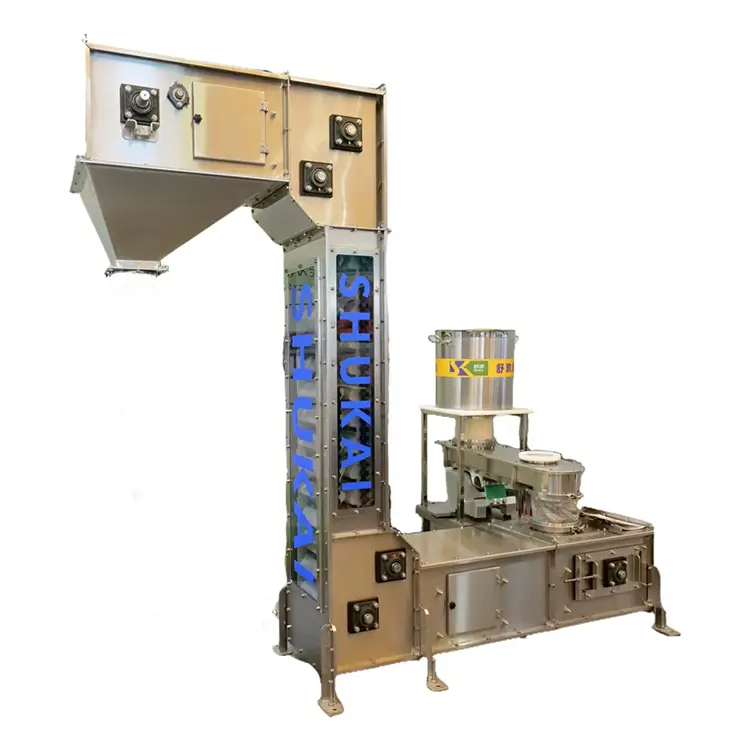How to Select the Right Bucket Conveyor
2025-09-01
Choosing the right bucket conveyor is critical for optimizing efficiency, reducing operational costs, and ensuring long-term reliability in material handling applications. This comprehensive guide will walk you through the key factors to consider when selecting a bucket conveyor, including design types, performance parameters, material compatibility, and operational requirements. We will also provide detailed technical specifications of Shukai’s industry-leading bucket conveyor systems, presented in clear lists and tables for easy comparison. By the end of this article, you will have the knowledge needed to make an informed decision that aligns with your operational goals.
Understanding Bucket Conveyors
A bucket conveyor is a type of vertical or inclined conveying system designed to move bulk materials—such as grains, minerals, chemicals, or aggregates—efficiently between different levels of a facility. These systems utilize buckets attached to a belt or chain to scoop, carry, and discharge materials, making them ideal for applications requiring high vertical lift or gentle handling of fragile products.
Bucket conveyors are widely used in industries like agriculture, mining, food processing, and manufacturing due to their ability to handle a diverse range of materials with minimal spillage and degradation.
Types of Bucket Conveyors
There are several types of bucket conveyors, each suited to specific applications:
-
Centrifugal Discharge Conveyors
Ideal for handling fine, free-flowing materials at high speeds. The buckets discharge material using centrifugal force. -
Continuous Discharge Conveyors
Designed for slower, controlled discharge of materials. Suitable for fragile or abrasive products. -
Positive Discharge Conveyors
Uses buckets mounted on chains and forced to tip over, ensuring complete discharge. Best for sticky or cohesive materials. -
Paddle Conveyors
Combines buckets with paddles for better handling of lightweight or fluffy materials.
Key Factors to Consider When Selecting a Bucket Conveyor
1. Material Characteristics
The properties of the material being handled significantly influence the choice of conveyor. Consider:
-
Bulk density
-
Particle size and shape
-
Moisture content
-
Abrasiveness
-
Temperature and corrosiveness
2. Capacity Requirements
Determine the required throughput (e.g., tons per hour or cubic meters per hour) to ensure the system meets production demands.
3. Lift Height and Inclination
The vertical distance and angle of conveyance affect the design and power requirements of the bucket conveyor.
4. Operating Environment
Factors such as temperature, humidity, and exposure to chemicals or dust may require specific materials or coatings for the conveyor components.
5. Power and Efficiency
Energy consumption and operational efficiency are critical for reducing long-term costs. Variable speed drives can help optimize performance.
6. Maintenance and Durability
Choose a system designed for easy maintenance and constructed from durable materials to minimize downtime.
Technical Specifications of Shukai Bucket Conveyors
Shukai offers a range of high-performance bucket conveyors designed for reliability and efficiency. Below are the detailed specifications for our standard models.
Standard Features:
-
High-strength steel or stainless steel construction
-
Anti-wear buckets with reinforced edges
-
Efficient drive systems with overload protection
-
Easy-access maintenance points
-
Customizable inlet and outlet configurations
Model Specifications Table:
| Model | Capacity (m³/h) | Max Lift Height (m) | Bucket Size (mm) | Power (kW) | Speed (m/s) | Material Options |
|---|---|---|---|---|---|---|
| SK-BC500 | 50 | 30 | 200x150 | 5.5 | 1.2–1.8 | Carbon Steel, Stainless |
| SK-BC750 | 75 | 35 | 250x180 | 7.5 | 1.5–2.0 | Stainless, Abrasion-Resist |
| SK-BC1000 | 100 | 40 | 300x200 | 11 | 1.8–2.2 | Stainless, Coated |
| SK-BC1500 | 150 | 45 | 350x220 | 15 | 2.0–2.5 | Hardened Steel, Stainless |
| SK-BC2000 | 200 | 50 | 400x250 | 18.5 | 2.2–2.8 | Stainless, Specialty Alloy |
Optional Accessories:
-
Wear-resistant liners
-
Dust-proof covers
-
Temperature sensors
-
Automated lubrication systems
-
Explosion-proof motors
How to Determine the Right Bucket Conveyor for Your Application
Step 1: Define Your Material Properties
Test the material’s flowability, abrasiveness, and other traits to determine the suitable bucket type and liner material.
Step 2: Calculate Required Capacity
Based on production goals, calculate the necessary volumetric and weight-based throughput.
Step 3: Evaluate Lift and Incline Needs
Measure the vertical distance and angle to select a model with adequate lift capability.
Step 4: Review Environmental Conditions
Ensure the conveyor materials and motors are compatible with the operating environment.
Step 5: Consider Future Scalability
Choose a system that can adapt to potential increases in production or changes in material type.
Why Choose Shukai Bucket Conveyors?
Shukai has been a trusted name in industrial conveying solutions for decades. Our bucket conveyors are engineered for durability, efficiency, and ease of maintenance. With a focus on innovation and customer satisfaction, we provide customized solutions that meet the unique needs of each client.
Our products are certified to international standards and come with comprehensive after-sales support, including installation guidance, training, and spare parts services.
Conclusion
Selecting the right bucket conveyor is a complex but essential process that can significantly impact your operation’s productivity and cost-efficiency. By understanding your material properties, capacity requirements, and environmental conditions, you can make a well-informed decision.
At Shukai, we are committed to delivering high-quality conveying solutions that stand the test of time. I encourage you to reach out to our team for personalized assistance or to request a quote. Let us help you optimize your material handling process—email us today at [email protected].



